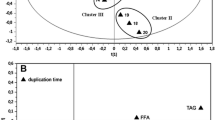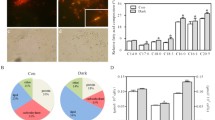Abstract
Although substantial economic barriers exist, marine diatoms such as Thalassiosira pseudonana and Phaeodactylum tricornutum hold promise as feedstock for biodiesel because of their ability to manufacture and store triacylglycerols (TAGs). The recent sequencing of these two marine diatom genomes by the United States Department of Energy Joint Genome Institute and the development of improved systems for genetic manipulation should allow a more systematic approach to understanding and maximizing TAG production. However, in order to best utilize these genomes and genetic tools, we must first gain a deeper understanding of the nutrient-mediated regulation of TAG anabolism. By determining both the yield and molecular species distribution of TAGs we will, in the future, be able to fully characterize the effects of genetic manipulation. Here, we lay the groundwork for understanding TAG production in T. pseudonana and P. tricornutum, as a function of nitrate and silicate depletion. Diatoms were starved of either nitrate or silicate, and TAGs were extracted with hexane from lyophilized samples taken at various time intervals following starvation. The timing of TAG production and the relative abundance of TAGs were estimated by fluorescence spectroscopy using Nile red and the total yield per biomass determined by gravimetric assay. TAGs were analyzed using thin layer chromatography, gas chromatography–mass spectrometry, and electrospray ionization mass spectrometry to identify the major TAG species produced during the growth curve. Under our conditions, the TAG yield from T. pseudonana is about 14–18% of total dry weight. The TAG yield from P. tricornutum is about 14% of total dry weight. Silicate-starved T. pseudonana accumulated an average of 24% more TAGs than those starved for nitrate; however, the chemotypes of the TAGs produced were generally similar regardless of the starvation condition employed.





Similar content being viewed by others
References
14105, E., BSI BS EN 14105 (2003) Fat and oil derivatives fatty acid methyl esters (FAME). Determination of free and total glycerol and mono-, di-, triglyceride contents (Reference method)
Alonso DL, Belarbi EH, Fernandez-Sevilla JM, Rodriguez-Ruiz J, Molina Grima E (2000) Acyl lipid composition variation related to culture age and nitrogen concentration in continuous culture of the microalga Phaeodactylum tricornutum. Phytochemistry 54:461–471
Armbrust EV, Berges JA, Bowler C, Green BR, Martinez D, Putnam NH, Zhou S, Allen AE, Apt KE, Bechner M, Brzezinski MA, Chaal BK, Chiovitti A, Davis AK, Demarest MS, Detter JC, Glavina T, Goodstein D, Hadi MZ, Hellsten U, Hildebrand M, Jenkins BD, Jurka J, Kapitonov VV, Kroger N, Lau WW, Lane TW, Larimer FW, Lippmeier JC, Lucas S, Medina M, Montsant A, Obornik M, Parker MS, Palenik B, Pazour GJ, Richardson PM, Rynearson TA, Saito MA, Schwartz DC, Thamatrakoln K, Valentin K, Vardi A, Wilkerson FP, Rokhsar DS (2004) The genome of the diatom Thalassiosira pseudonana: ecology, evolution, and metabolism. Science 306:79–86
Beer S, Stewart AJ, Wetzel RG (1982) Measuring chlorophyll a and C-labeled photosynthate in aquatic angiosperms by the use of a tissue solubilizer. Plant Physiol 69:54–57
Ben-Amotz A, Tornabene TG, Thomas WH (1985) Chemical profile of selected species of microalgae with emphasis on lipids. J Phycol 21:72–81
Cooksey KE, Guckert JB, Williams SA, Callis PR (1987) Fluorometric determination of the neutral lipid content of microalgal cells using Nile red. J Microbiol Methods 6:333–345
Eder K (1995) Gas chromatographic analysis of fatty acid methyl esters. J Chromatogr B 671(1–2):113–131
Fisher NS, Schwarzenbach RP (1978) Fatty acid dynamics in Thalassiosira pseudonana (Bacillariophyceae): implications for physiological ecology. J Phycol 14:143–150
Han X, Gross RW (2001) Quantitative analysis and molecular species fingerprinting of triacylglyceride molecular species directly from lipid extracts of biological samples by electrospray ionization tandem mass spectrometry. Anal Biochem 295:88–100
Harrison PJ, Waters R, Taylor FJR (1980) A broad spectrum artificial seawater medium for coastal and open ocean phytoplankton. J Phycol 16:28–35
Hsu F-F, Turk J (1999) Structural characterization of triacylglycerols as lithiated adducts by electrospray ionization mass spectrometry using low-energy collisionally activated dissociation on a triple stage quadrupole instrument. J Am Soc Mass Spectrom 10:587–599
Hu Q, Sommerfeld M, Jarvis E, Ghirardi M, Posewitz M, Seibert M, Darzins A (2008) Microalgal triacylglycerols as feedstocks for biofuel production: perspectives and advances. Plant J 54(4):621–639
Knothe G (2005) Dependence of biodiesel fuel properties on the structure of fatty acid alkyl esters. Fuel Process Technol 86:1059–1070
Laakso P (2002) Mass spectrometry of triacylglycerols. Eur J Lipid Sci Tech 104:43–49
Malavolta M, Bocci F, Boselli E, Frega NG (2004) Normal phase liquid chromatography-electrospray ionization tandem mass spectrometry analysis of phospholipid molecular species in blood mononuclear cells: applications to cystic fibrosis. J Chromatogr B 810(2):173–186
Maloney M (1996) Thin-layer chromatography in bacteriology. In: Fried B, Sherma J (eds) Practical thin-layer chromatography: a multidisciplinary approach. CRC, Boca Raton, p 336
Mansour MP, Volkman JK, Jackson AE, Blackburn SI (1999) The fatty acid and sterol composition of five marine dinoflagellates. J Phycol 35:710–720
Mansour MP, Frampton DMF, Nichols PD, Volkman JK, Blackburn SI (2005) Lipid and fatty acid yield of nine stationary-phase microalgae: applications and unusual C24–C28 polyunsaturated fatty acids. J Appl Phycol 17:287–300
Mock T, Samanta MP, Iverson V, Berthiaume C, Robison M, Holtermann K, Durkin C, Bondurant SS, Richmond K, Rodesch M, Kallas T, Huttlin EL, Cerrina F, Sussman MR, Armbrust EV (2008) Whole genome expression profiling of the marine diatom Thalassiosira pseudonana identifies genes involved in silicon bioprocesses. Proc Natl Acad Sci USA 105:1579–1584
Murphy RC, Fiedler J, Hevko J (2001) Analysis of non-volatile lipids by mass spectrometry. Chem Rev 101(2):479–526
Nota G, Musso SS, Naviglio D, Romano R, Sabia V (1999) Determination of sterols and their esters in fats by way of transesterification in different solvents. Anal Lett 32:811–825
Ponomarenko LP, Stonik IV, Aizdaicher NA, Orlova TY, Popovskaya GI, Pomazkina GV, Stonik VA (2004) Sterols of marine microalgae Pyramimonas cf. cordata (Prasinophyta), Attheya ussurensis sp. nov. (Bacillariophyta) and a spring diatom bloom from Lake Baikal. Comp Biochem Physiol B 138(1):65–70
Poulsen N, Kroger N (2005) A new molecular tool for transgenic diatoms: control of mRNA and protein biosynthesis by an inducible promoter-terminator cassette. FEBS J 272:3413–3423
Poulsen N, Berne C, Spain J, Kroger N (2007) Silica immobilization of an enzyme through genetic engineering of the diatom Thalassiosira pseudonana. Angew Chem 46:1843–1846
Roessler PG (1988) Changes in the activities of various lipid and carbohydrate biosynthetic enzymes in the diatom Cyclotella cryptica in response to silicon deficiency. Arch Biochem Biophys 267:521–528
Sasaki GC, Capuzzo JM (1984) Degradation of Artemia lipids under storage. Comp Biochem Physiol B 78:525–531
Schmelzer K, Fahy E, Subramaniam S, Dennis EA, Brown HA (2007) The lipid maps initiative in lipidomics. Methods Enzymol 432:171–183
Sheehan J, Dunahay T, Benemann J, and Roessler P (1998) A look back at the U.S. Department of Energy’s Aquatic Species program: biodiesel from algae. National Renewable Energy Laboratory, Report NREL/TP-580-24190
Tonon T, Harvey D, Larson TR, Graham IA (2002) Long chain polyunsaturated fatty acid production and partitioning to triacylglycerols in four microalgae. Phytochemistry 61:15–24
Yongmanitchai W, Ward OP (1993) Molecular species of triacylglycerols from the freshwater diatom, Phaeodactylum tricornutum. Phytochemistry 32:1137–1139
Zaslavskaia LA, Lippmeier JC, Kroth PG, Grossman AR, Apt KE (2000) Transformation of the diatom Phaeodactylum tricornutum (Bacillariophyceae) with a variety of selectable marker and reporter genes. J Phycol 36:379–386
Zaslavskaia LA, Lippmeier JC, Shih C, Ehrhardt D, Grossman AR, Apt KE (2001) Trophic conversion of an obligate photoautotrophic organism through metabolic engineering. Science 292:2073–2075
Zhukova NV (2004) Changes in the lipid composition of Thalassiosira pseudonana during its life cycle. Russ J Plant Physiol 51:702–707
Acknowledgments
We would like to acknowledge Dr. Kenneth Sale for his careful reading of the manuscript. This work was supported by the Laboratory Directed Research and Development program at Sandia National Laboratories, which is a multi-program laboratory operated by Sandia Corp., a Lockheed Martin company, for the United States Department of Energy under contract no. DE-AC04-94AL85000.
Author information
Authors and Affiliations
Corresponding author
Electronic supplementary material
Below is the image is a link to a high resolution version.
Supplementary Figure 1
Tandem mass spectrum of lithiated TAG species (50:5) at m/z 831.7. Fragment ions reflect the loss of each fatty acid substituent and are observed at m/z values corresponding to [M+Li-(RnCO2H)]* and [M+Li-(RnCO2Li)] (peaks are bracketed in the figure). Product ions formed reveals two possible fatty acid compositions (14:0/16:0/20:5 and 16:0/16:1/18:4) that are consistent with the molecular composition of TAG 50:5. The relative abundances of the product ions show that the predominant FA composition for TAG 50:5 is 16:0/16:1/18:4 (GIF 108 kb)
Below is the link to the electronic supplementary material.
Supplementary Table 1
Full list of TAG molecular weight identified in hexane extracts from T. pseudonana and P. tricornutum during growth cycle (DOC 310 kb)
Rights and permissions
About this article
Cite this article
Yu, E.T., Zendejas, F.J., Lane, P.D. et al. Triacylglycerol accumulation and profiling in the model diatoms Thalassiosira pseudonana and Phaeodactylum tricornutum (Baccilariophyceae) during starvation. J Appl Phycol 21, 669–681 (2009). https://doi.org/10.1007/s10811-008-9400-y
Received:
Revised:
Accepted:
Published:
Issue Date:
DOI: https://doi.org/10.1007/s10811-008-9400-y




